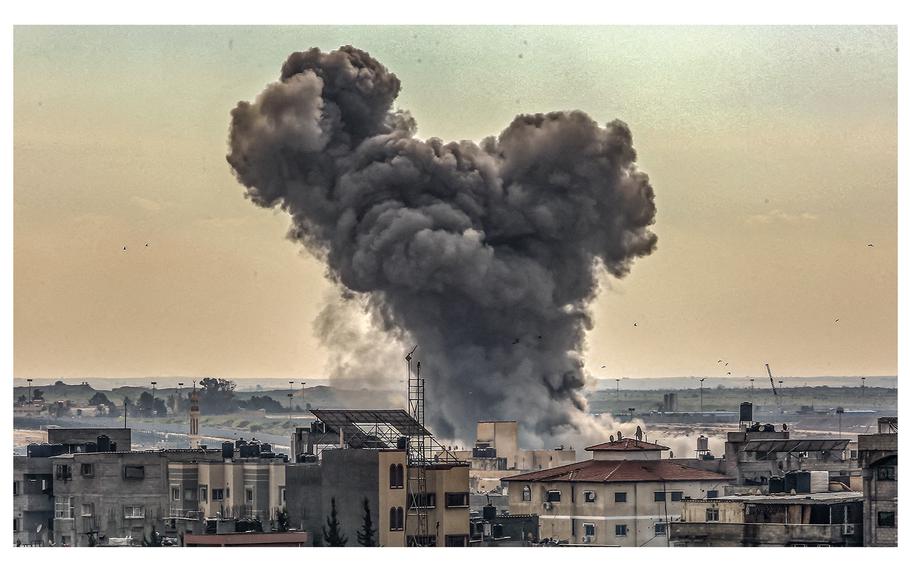
Smoke rises from buildings after Israeli airstrikes in Rafah, on Dec. 14, 2023. ()
In a fit of ideological pique last week, Rep. Lauren Boebert, R-Colo., scoffed at protesters agitating against pro-Israel policies on campuses across the United States. “I get a strange inkling that all these Columbia and UCLA students running around yelling ‘Free Palestine’ would not be jumping at the opportunity to do a semester abroad in Gaza,” she wrote on social media, before later journeying to a protest encampment at George Washington University and almost sparring with students when trying to pull down a Palestinian flag.
Boebert’s scorn is shared even by some of her opponents in the Washington establishment, many of whom have cast the student demonstrations as, at best, unproductive far-left agitprop or, more darkly, dangerous antisemitic behavior that must be expunged from the academy. Hundreds of campus protesters have been arrested in recent days in police crackdowns from California to New York.
Boebert’s comment, though, drew derision on two counts: First, that protesters angry about alleged Israeli war crimes in Gaza would need to go to the besieged territory itself to justify their anger. And, second, that students could even do “a semester abroad” in Gaza, where Israel has spent the past half year systematically destroying most of its educational institutions, including all of its universities.
For months, Palestinian civil society activists have drawn attention to the steady eradication of Gaza’s cultural patrimony. Israel’s punishing campaign against militant group Hamas has seen much of the territory reduced to ruin. In the process, many libraries, museums and colleges have been ransacked and razed — in some instances, by deliberate Israeli demolition. Thousands of artifacts in various collections, including Roman coins and other materials from Gaza’s pre-Islamic past, have been potentially lost during the war.
The hysteria over campus protests in the United States has shifted American attention away from the depth of the ongoing calamity in Gaza. U.N. officials and aid agencies are still grappling with the scale of the destruction in the territory, where dozens are still dying every day. Since Hamas launched its Oct. 7 terrorist strike on southern Israel, more than 34,500 Palestinians in the territory — many of them women and children — have been killed. Some 5 percent of Gaza’s overall population has been killed or injured, according to a U.N. report that cites local data.
That figure doesn’t include the more than at least 10,000 people that the U.N. estimates are still missing beneath the rubble, citing the Palestinian Civil Defense (PCD). The challenge of finding the missing is growing more dire, given the widespread destruction of heavy machinery and equipment needed to dig through the debris.
“Rising temperatures can accelerate the decomposition of bodies and the spread of disease,” the U.N. humanitarian affairs office said in a statement, adding that the PCD was appealing to “all relevant stakeholders to urgently intervene to allow the entry of needed equipment, including bulldozers and excavators, to avert a public health catastrophe, facilitate dignified burials, and save the lives of injured people.”
Sifting through Gaza’s wreckage will be no simple task. Israel has dumped a huge amount of ordnance on the territory. Mungo Birch, head of the U.N. Mine Action Program in Palestinian territory, said last week that the amount of unexploded missiles and bombs lying in the rubble is “unprecedented” since World War II. He said tiny Gaza is a site of some 37 million tons of rubble — more than what’s been generated across all of Ukraine during Russia’s war — and 800,000 tons of asbestos and other contaminants. He said his agency has only a fraction of the funding it needs to begin clearing operations whenever the war ends.
Over the weekend, U.S. and Egyptian officials attempted to facilitate a last-ditch effort to broker a truce between Israel and Hamas. A delegation from the Palestinian militant group was in Cairo and expressed optimism that a breakthrough could be found. Israeli Prime Minister Benjamin Netanyahu, who faced mass protests at home against his continued tenure in office, seemed more wary of the arrangement and remains bent on carrying out a full offensive against the southern Gazan city of Rafah, where more than a million Palestinians already displaced in the territory have taken shelter.
Top U.N. officials say famine has already gripped parts of Gaza. Beyond the desperately insufficient trickle of humanitarian aid into the territory, the war has also “severely hampered” Gaza’s “ability to produce food and clean water,” according to The Washington Post. “Israeli airstrikes and bulldozers have razed farms and orchards. Crops abandoned by farmers seeking safety in southern Gaza have withered, and cattle have been left to die.”
The fear surrounding Rafah and the uncertainty over a potential cease-fire sit against the looming reality of how difficult it will be for Gaza to recover. More than 70 percent of all housing in the territory has been destroyed. A report by the U.N. Development Program (UNDP) found that the war has reversed 40 years of development and improvement in social indicators such as life expectancy, health and educational attainment in Gaza.
The agency estimated that reconstruction, at this point, would cost some $40 billion to $50 billion. And if it follows the pace observed after previous conflicts, UNDP estimates that it will take “approximately 80 years to restore all the fully destroyed housing units” in Gaza.
“My very big concern — in addition to the numbers — is the breaking down of communities and families in Gaza,” UNDP regional director Abdallah al-Dardari told The Washington Post. “If you know 60 people in your family have been killed — like our colleague Issam al-Mughrabi who was killed with 60 people in his family during one raid — you will go numb,” Dardari said. “The consequences of this war will stay with us far beyond the end of the war.”